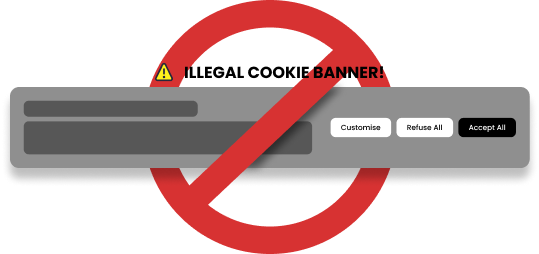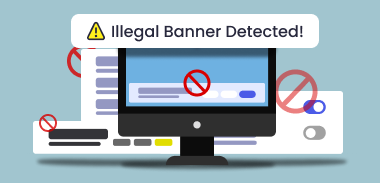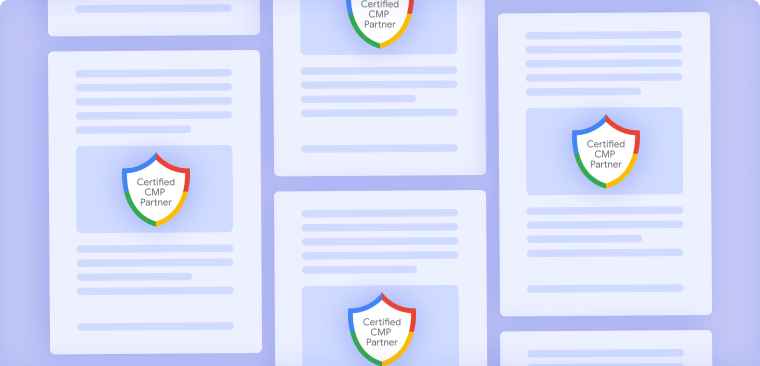Why Your Cookie Banner Is Probably Illegal (And What to Do About It)
April 21, 2025
•
4 min read
Table of contents
back
to the top
Your website’s cookie consent banner might be breaking the law without you even realizing it. Many cookie banners that seem fine at first glance are actually not GDPR compliant. Regulators have set strict cookie banner requirements under the EU’s GDPR and ePrivacy Directive, and non-compliant banners have led to warnings and hefty fines. In this post, we’ll explain the common reasons your cookie notice may be illegal – and more importantly, what to do about it to ensure GDPR compliance and build user trust.

What Makes a Cookie Banner Illegal?
Let’s break down the most common violations:
1. Pre-ticked Boxes or Implied Consent
The GDPR requires explicit, affirmative consent — that means users must actively choose to accept cookies. Pre-ticked boxes or banners that assume consent if a user continues browsing are a clear violation. This was confirmed in the Planet49 case by the Court of Justice of the EU, which clarified that consent must be “freely given, specific, informed and unambiguous.”
2. No Option to Reject Non-Essential Cookies
A compliant cookie banner must offer a real choice. If the “Accept” button is bright and prominent, but rejecting cookies takes multiple steps or is hidden under additional clicks, regulators will flag it. The CNIL and other European data authorities have explicitly stated that consent must be just as easy to withdraw or deny as it is to give.
3. Lack of Specificity
Many banners ask users to accept “cookies” in general, without specifying what types of cookies are being used, by whom, or for what purpose. That’s not enough. Users must be able to give granular consent — for example, agreeing to analytics cookies but rejecting marketing ones.
4. No Proof of Consent
Even if your banner collects consent correctly, you’re not off the hook. The GDPR requires proof of consent. That means storing records of when and how users gave their permission — and being able to present that record in case of an audit or complaint.
What to Do If Your Cookie Banner Is Illegal
1. Audit Your Current Setup
Start by reviewing your existing banner:
- Are non-essential cookies blocked until consent is given?
- Can users easily refuse cookies?
- Is consent specific, informed, and unambiguous?
- Are there detailed options (e.g., analytics vs. marketing)?
- Is consent being recorded and stored properly?
2. Update Your Consent Mechanism
Make sure your banner:
- Offers equal prominence to “Accept” and “Reject” options
- Uses no pre-ticked checkboxes
- Gives users the ability to granularly choose cookie categories
- Includes links to your privacy and cookie policies
Use a Consent Management Platform (CMP) that aligns with GDPR and ePrivacy Directive standards.
3. Implement Prior Consent Blocking
Non-essential cookies (like tracking, advertising, or analytics) must not load before the user gives explicit consent. Use scripts that only activate cookies after permission is granted.
4. Stay Updated on Privacy Laws
Regulations like the GDPR evolve. The ePrivacy Regulation, CCPA, CNIL, and other global privacy laws may introduce changes.
5. Educate Your Team
Make sure your marketing, legal, and web teams understand their roles in compliance. Privacy isn’t just a checkbox — it’s a shared responsibility.
6. Use a Reputable CMP
How CookiePal.io Solves These Problems
CookiePal.io was built to solve exactly these challenges. Here’s how it ensures your website is on the right side of privacy law:
- Granular Controls – Let users choose between strictly necessary, analytics, and marketing cookies.
- Equal Choice Design – Both “Accept” and “Reject” options are given equal prominence, reducing dark patterns.
- Automated Cookie Scans – Keep your consent records up to date with automatic detection and categorization of new cookies.
- Consent Records – Securely store consent logs with timestamped records, ensuring full GDPR audit-readiness.
Why This Matters — Beyond Compliance
Yes, fines are a risk. But non-compliance also hurts user trust and brand reputation. Visitors are increasingly privacy-aware — and they’re more likely to convert on websites that are transparent and respectful of their data.
In fact, a privacy-respecting UX can be a competitive advantage. When users feel in control, they’re more likely to engage, sign up, or make a purchase.
Final Takeaway
The cookie banner isn’t just a checkbox — it’s a legal obligation and a trust signal. Most banners fail not because site owners don’t care, but because the rules are more nuanced than they appear.
With tools like CookiePal.io, compliance doesn’t have to be complicated. You can stay within the law, respect your users, and sleep better knowing your website won’t be the next GDPR headline.
Sources:
- CNIL - https://www.cnil.fr/en/home
- Google Consent Requirements - https://support.google.com/admanager/answer/9012903?hl=en
- GDPR.eu - https://gdpr.eu/
- CJEU Planet49 ruling - https://op.europa.eu/en/
- EDPB Guidelines - https://gdprhub.eu/CJEU*-_C-673/17*-_Planet49
- ePrivacy Directive - https://eur-lex.europa.eu/legal-content/EN/TXT/?uri=CELEX%3A32002L0058
Explore further

Cookiepal vs Free Cookie Banners: Why Compliance Costs Less Than Fines
Cookiepal vs free banners: why paid CMPs save you money, reduce legal risk, and boost trust—free plugins often lack GDPR compliance, logs, and consent controls.
November 13, 2025
2 min

GDPR and Email Marketing: How to Stay Compliant
Ensure GDPR compliance in your email marketing by following best practices for consent, clear opt-out options, and accurate data management.
September 13, 2024
2 min

Is Google Consent Mode Enough for GDPR Compliance
Is Google Consent Mode enough for GDPR? Learn what it does, its limitations, and why you need a Google‑certified CMP for true compliance—all in one concise guide.
July 25, 2025
4 min


